So I have been studying LSA extraction methods for a while now, but the only way seems to be using the morning glory seeds by grinding then up and soaking them in alcohol or lemon water for a few hours. Then straining out the seeds leaving the LSA behind in the alcohol. Now I’ve started to notice that there is a massive amount of what appears to be pearly gates morning glory's around where I live however they still have a few months until they die and produce seeds. I know that there is a significantly larger concentration of LSA in the seeds but I want to have a way of extracting LSA from morning glory's in the seasons where they can't produce seeds. I also heard that there is something called morning glory tea where you soak the leaves and flowers in water for a few months and drink the fermented wine it produces. Now I was wondering, if I had enough of these flowers and leaves, could I do the original seed extraction method with the flowers and leaves instead of seeds? Earlier in the day I collected about a grocery bag full of flowers and leaves and ground it all up. Then I put it in a jar and filled it with about three shots of tequila and a squeezed lemon. I'm gonna mix it and leave it there over night and strain the alcohol out in the morning. Has anyone tried this or verify if this will work? I'm defiantly not going to drink this concoction if I cant find any information on whether it will work or not but if i can get some verification or changes in my recipe I'll try to write a trip report on the effects if any.
-
Psychedelic Drugs Welcome Guest
PD's Best Threads Index Social ThreadSupport Bluelight Psychedelic Beginner's FAQ
You are using an out of date browser. It may not display this or other websites correctly.
You should upgrade or use an alternative browser.
You should upgrade or use an alternative browser.
LSA Extraction from Morning Glory Flowers and Leaves
- Thread starter N3419p
- Start date
Solipsis
Bluelight Crew
- Joined
- Mar 12, 2007
- Messages
- 15,509
Hi welcome to PD / bluelight
LSA Extraction from Morning Glory flowers (well flowers? they are not really described)
I'd use maybe the flowers but leaves and stems sound like they can really contribute to side-effects, unless you can really purify your product. And extra side effects is the last thing you need with LSA-containing plants.
The idea of fermenting the flower beverage is to get alcohol that extracts your LSA's better, but you can also just use something like vodka to extract right away. Or without it just a CWE which is less efficient.
The recipe is ancient though and was perhaps used for ritual meaning and the alcohol content only. There may very well not be any significant amounts of LSA in the flowers, there isn't even that much in the seeds and they contain the most.
I would really just wait if I were you.
LSA Extraction from Morning Glory flowers (well flowers? they are not really described)
The stems and the leaves contain some alkaloid. However, because they contain purgative principles, this part of the plant is only used in extractions. If used, pick fresh and dry quickly without heat.
I'd use maybe the flowers but leaves and stems sound like they can really contribute to side-effects, unless you can really purify your product. And extra side effects is the last thing you need with LSA-containing plants.
The idea of fermenting the flower beverage is to get alcohol that extracts your LSA's better, but you can also just use something like vodka to extract right away. Or without it just a CWE which is less efficient.
The recipe is ancient though and was perhaps used for ritual meaning and the alcohol content only. There may very well not be any significant amounts of LSA in the flowers, there isn't even that much in the seeds and they contain the most.
I would really just wait if I were you.
Last edited:
phuckingnutz
Bluelighter
- Joined
- Mar 11, 2014
- Messages
- 1,416
I think that the source of LSA is from a fungus that grows on the seeds, I don't think it is a systemic thing, but IDK for sure.
This report says only trace amounts were found in the leaves.
Weber JM, Ma TS, 1976, Microchemical investigations of medicinal plants. XIII. Separation of the alkaloids in the leaves of Ipomoea violacea using thin layer chromatography. Microchimica Acta (Impact Factor: 3.43). 02/1976
Get a copy in my MG seed info archive: http://www.bluelight.org/vb/entries/7141-morning-glory-seed-information-archive
Additional info:
The leaves contain the ergot alkaloids (ergoline derivatives) ergometrine, isolysergic acid amide, and lysergic acid amide (LSA). The biosynthesis of these indole alkaloids occurs in the leaves, while the subsequent translocalization leads to an accumulation of the alkaloids in the seeds.
The Encyclopedia of Psychoactive Plants. Christian Rätsch (2005), p. 300
Weber JM, Ma TS, 1976, Microchemical investigations of medicinal plants. XIII. Separation of the alkaloids in the leaves of Ipomoea violacea using thin layer chromatography. Microchimica Acta (Impact Factor: 3.43). 02/1976
Get a copy in my MG seed info archive: http://www.bluelight.org/vb/entries/7141-morning-glory-seed-information-archive
Additional info:
The leaves contain the ergot alkaloids (ergoline derivatives) ergometrine, isolysergic acid amide, and lysergic acid amide (LSA). The biosynthesis of these indole alkaloids occurs in the leaves, while the subsequent translocalization leads to an accumulation of the alkaloids in the seeds.
The Encyclopedia of Psychoactive Plants. Christian Rätsch (2005), p. 300
Last edited:
- Joined
- Mar 9, 2005
- Messages
- 33,317
I think that the source of LSA is from a fungus that grows on the seeds, I don't think it is a systemic thing, but IDK for sure.
I don't know about that Phuck...That would suggest that a secondary fungus source of ergolines exists and has also developed a complicated and exclusive symbiotic relationship with a very limited family of plants. I'm pretty sure that the primary alkaloid content is found within the actual seeds...
Finding myself drawn to your italicised posts phuck, inspired by them you could say...
phuckingnutz
Bluelighter
- Joined
- Mar 11, 2014
- Messages
- 1,416
Finding myself drawn to your italicised posts phuck, inspired by them you could say...
Yes, I drew too much heat for using CAPS for emphasis,,, so I resorted to italics...you know what they say..."when in Italy, Italicize.
Phuck's right.
Kucht S, Gross J, Hussein Y, Grothe T, Keller U, Basar S, König WA, Steiner U, Leistner E. Elimination of ergoline alkaloids following treatment of Ipomoea asarifolia (Convolvulaceae) with fungicides. Planta. 2004 Aug;219(4):619-25
Steiner U, Ahimsa-Müller MA, Markert A, Kucht S, Groß J, Kauf J, Kuzma M, Zych M, Lamshöft M, Furmanova M, Knoop V, Drewke C, Leistner E (2006) Molecular characterization of a seed transmitted clavicipitaceous fungus occurring on dicotyledoneous plants. Planta 224:533-544
Ahimsa-Müller MA, Markert A, Hellwig S, Knoop V, Steiner U, Drewke C, Leistner E. Clavicipitaceous fungi associated with ergoline alkaloid-containing convolvulaceae. J Nat Prod. 2007 Dec;70(12):1955-60
Markert A, Steffan N, Ploss K, Hellwig S, Steiner U, Drewke C, Li SM, Boland W, Leistner E. Biosynthesis and Accumulation of Ergoline Alkaloids in a Mutualistic Association between Ipomoea asarifolia (Convolvulaceae) and a Clavicipitalean Fungus. Plant Physiol. 2008 May;147(1):296-305. doi: 10.1104/pp.108.116699
Full copies available in my MG seed info archive: http://www.bluelight.org/vb/entries/7141-morning-glory-seed-information-archive
Overview of the research:
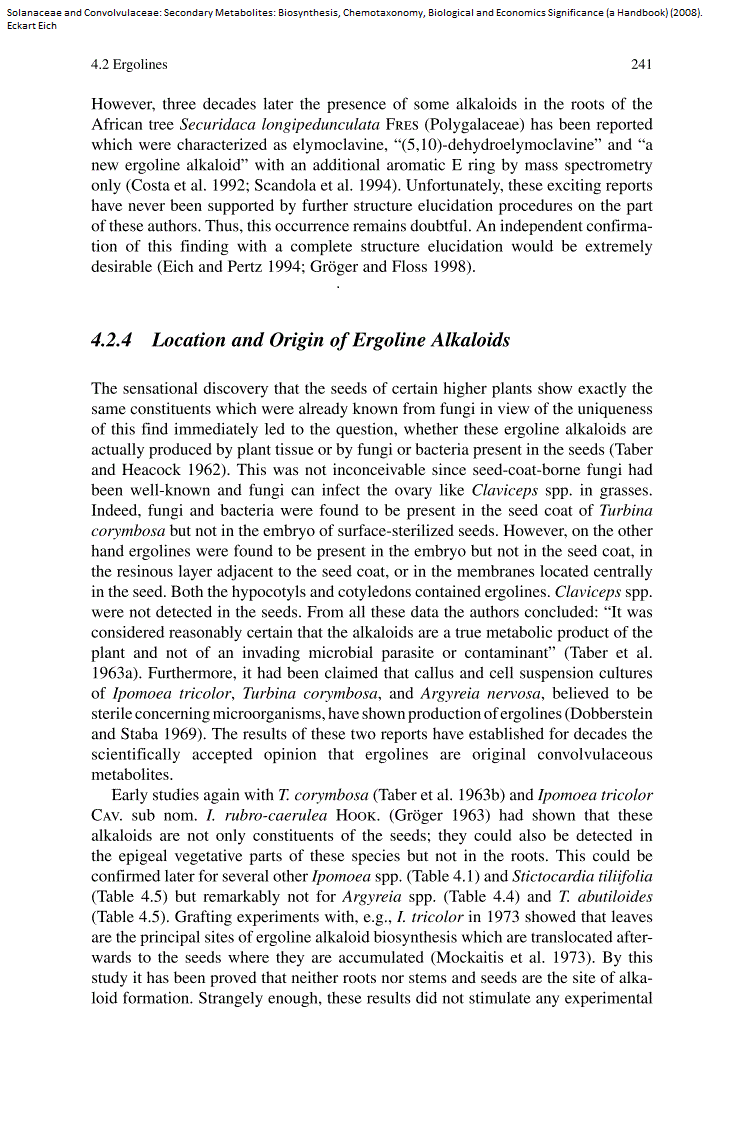
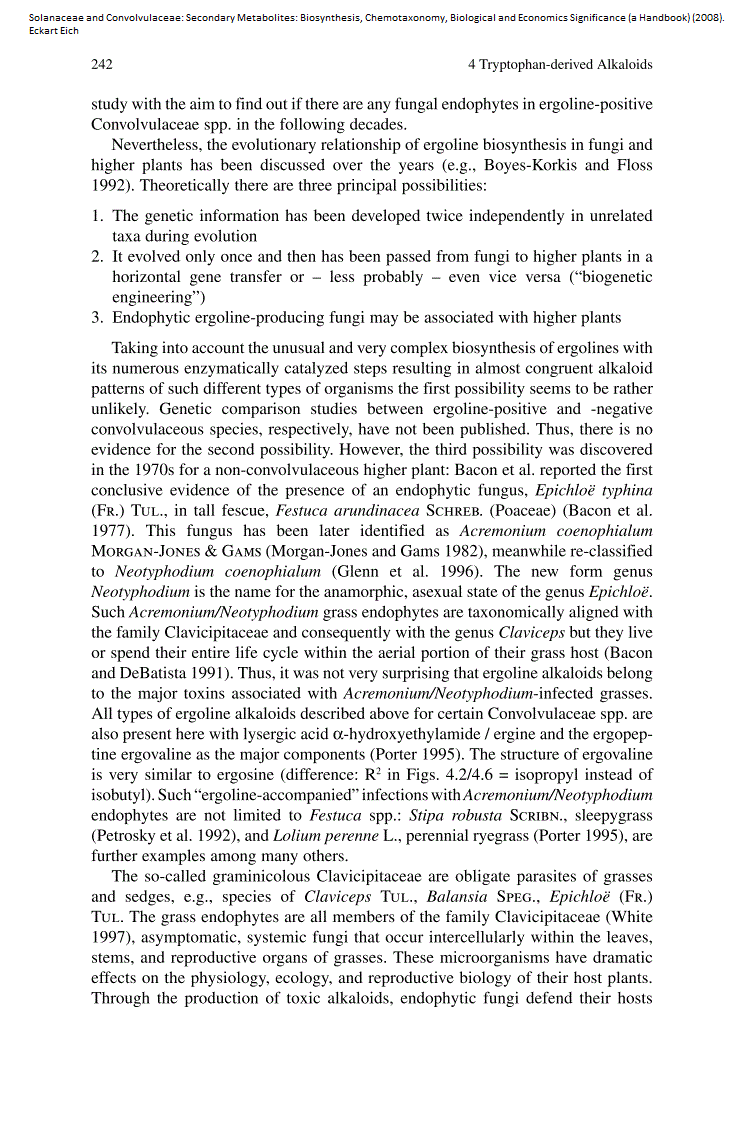
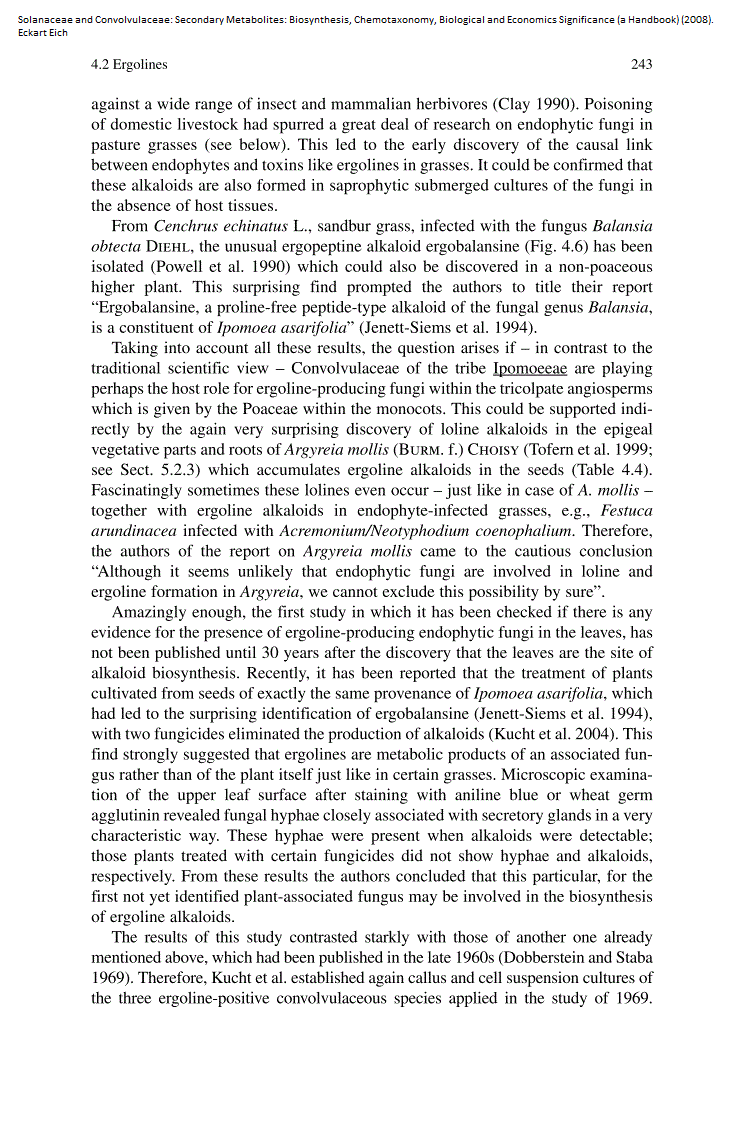
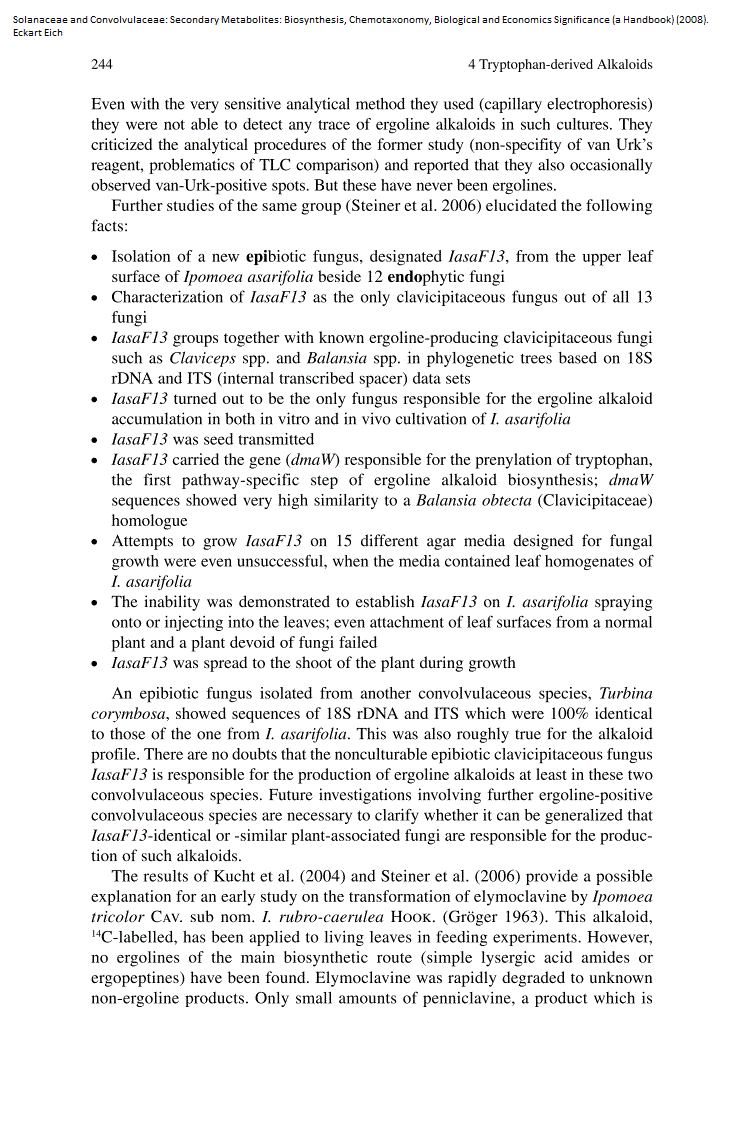
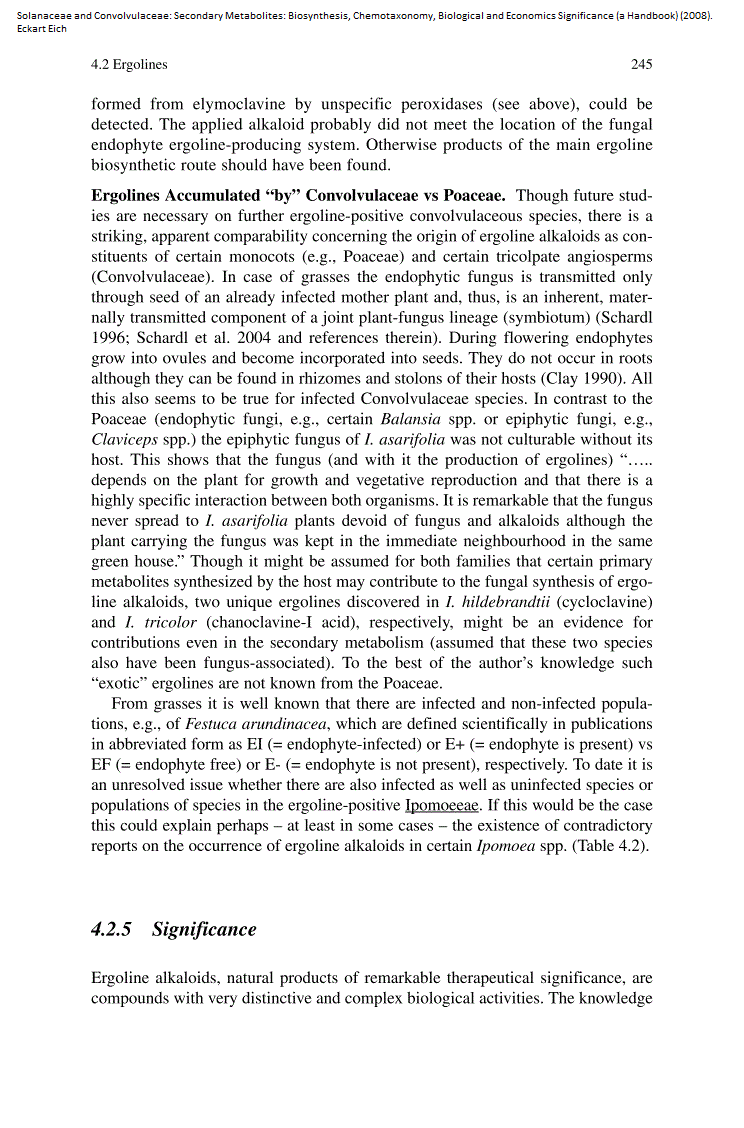
Taber WA, Heacock RA (1962) Location of ergot alkaloid and fungi in the seed of Rivea corym- bosa (L.) Hall. , “Ololiuqui”. Canad J Microbiol 8:137-143
Taber WA, Vining LC, Heacock RA (1963a) Clavine and lysergic acid alkaloids in varieties of morning glory. Phytochemistry 2:65-70
Dobberstein RH, Staba EJ (1969) Ipomoea, Rivea and Argyreia tissue cultures: Influence of vari- ous chemical factors on indole alkaloid production and growth. Lloydia/J Nat Prod 32:141-147
Taber WA, Heacock RA, Mahon ME (1963b) Ergot-type alkaloids in vegetative tissue of Rivea corymbosa (L.) Hall. f. Phytochemistry 2:99-101
Gröger D (1963) Über das Vorkommen von Ergolinderivaten in Ipomoea-Arten. Flora
153:373-382
Mockaitis JM, Kivilaan A, Schulze A (1973) Studies of the loci of indole alkaloid biosynthesis and alkaloid translocation in Ipomoea violacea plants. Biochemie und Physiologie der Pflanzen 164:248-257
Boyes-Korkis JM, Floss HG (1992) Biosynthesis of ergot alkaloids: Some new results on an old problem. Prikl Biokhim Mikrobiol 28:843-857
Bacon CW, Porter JK, Robbins JD, Lutrell ES (1977) Epichloë typhina from toxic tall fescue grasses. Appl Environ Microbiol 34:576-581
Morgan-Jones G, Gams W (1982) Notes on Hyphomycetes. XLI. An endophyte of Festuca arundinacea and the
anamorph of Epichloë typhina, new taxa in one of two new sections of Acremonium. Mycotaxon 15:311-318
Glenn AE, Bacon CW, Price R, Hanlin RT (1996) Molecular phylogeny of Acremonium and its taxonomic implications. Mycologia 88: 369-383
Bacon CW, DeBattista J (1991) Endophytic fungi of grasses. In: Arora DK, Rai B, Mukerji KG, Knudsen GR (eds) Handbook of applied microbiology. Soils and plants, vol 1. Marcel Dekker, New York, p 231
Porter JK (1995) Analysis of endophyte toxins: fescue and other grasses toxic to livestock. J Anim Sci 73:871-880
Petroski RJ, Powell RG, Clay K (1992) Alkaloids of Stipa robusta (sleepygrass) infected with an Acremonium endophyte. Nat Tox 1:84-88
White JF Jr (1997) Systematics of the graminicolous Clavicipitaceae. In: Bacon CW, Hill SH (eds) Neotyphodium/grass interactions. Plenum Press, New York, pp 27-39
Clay K (1990) Fungal endophytes of grasses. Annu Rev Ecol Syst 21:275-297
Powell RG, Plattner RD, Yates SG, Clay K, Leuchtmann A (1990) Ergobalansinine, a new ergot- type peptide alkaloid isolated from Cenchrus echinatus (sandbur grass) infected with Balansia obtecta, and produced in liquid cultures of B. obtecta and Balansia cyperi. J Nat Prod 53:1272-1279
Jenett-Siems K, Kaloga M, Eich E (1994) Ergobalansine/ergobalansinine, a proline-free peptide- type alkaloid of the fungal genus Balansia, is a constituent of Ipomoea piurensis. J. Nat. Prod.57:1304-1306; Erratum: Correction of the species: I. asarifolia (Desr.) R. & Sch. (2004) J Nat Prod 67:2160
Tofern B, Kaloga M, Witte L, Hartmann T, Eich E (1999) Occurrence of loline alkaloids in Argyreia mollis (Convolvulaceae). Phytochemistry 51:1177-1180
Kucht S, Groß J, Hussein Y, Grothe T, Keller U, Basar S, König WA, Steiner U, Leistner E (2004) Elimination of
ergoline alkaloids following treatment of Ipomoea asarifolia (Convolvulaceae) with fungicides. Planta
219:619-625
Steiner U, Ahimsa-Müller MA, Markert A, Kucht S, Groß J, Kauf J, Kuzma M, Zych M, Lamshöft M , Furmanova M, Knoop V, Drewke C, Leistner E (2006) Molecular characterization of a seed transmitted clavicipitaceous fungus occurring on dicotyledoneous plants. Planta 224:533-544
Schardl CL (1996) Epichloë species: fungal symbionts of grasses. Annu Rev Phytopathol 34:109-130
Schardl CL, Leuchtmann A, Spiering MJ (2004) Symbioses of grasses with seedborne fungal endophytes. Annu Rev Plant Biol 55:315-340
Kucht S, Gross J, Hussein Y, Grothe T, Keller U, Basar S, König WA, Steiner U, Leistner E. Elimination of ergoline alkaloids following treatment of Ipomoea asarifolia (Convolvulaceae) with fungicides. Planta. 2004 Aug;219(4):619-25
Steiner U, Ahimsa-Müller MA, Markert A, Kucht S, Groß J, Kauf J, Kuzma M, Zych M, Lamshöft M, Furmanova M, Knoop V, Drewke C, Leistner E (2006) Molecular characterization of a seed transmitted clavicipitaceous fungus occurring on dicotyledoneous plants. Planta 224:533-544
Ahimsa-Müller MA, Markert A, Hellwig S, Knoop V, Steiner U, Drewke C, Leistner E. Clavicipitaceous fungi associated with ergoline alkaloid-containing convolvulaceae. J Nat Prod. 2007 Dec;70(12):1955-60
Markert A, Steffan N, Ploss K, Hellwig S, Steiner U, Drewke C, Li SM, Boland W, Leistner E. Biosynthesis and Accumulation of Ergoline Alkaloids in a Mutualistic Association between Ipomoea asarifolia (Convolvulaceae) and a Clavicipitalean Fungus. Plant Physiol. 2008 May;147(1):296-305. doi: 10.1104/pp.108.116699
Full copies available in my MG seed info archive: http://www.bluelight.org/vb/entries/7141-morning-glory-seed-information-archive
Overview of the research:





Taber WA, Heacock RA (1962) Location of ergot alkaloid and fungi in the seed of Rivea corym- bosa (L.) Hall. , “Ololiuqui”. Canad J Microbiol 8:137-143
Taber WA, Vining LC, Heacock RA (1963a) Clavine and lysergic acid alkaloids in varieties of morning glory. Phytochemistry 2:65-70
Dobberstein RH, Staba EJ (1969) Ipomoea, Rivea and Argyreia tissue cultures: Influence of vari- ous chemical factors on indole alkaloid production and growth. Lloydia/J Nat Prod 32:141-147
Taber WA, Heacock RA, Mahon ME (1963b) Ergot-type alkaloids in vegetative tissue of Rivea corymbosa (L.) Hall. f. Phytochemistry 2:99-101
Gröger D (1963) Über das Vorkommen von Ergolinderivaten in Ipomoea-Arten. Flora
153:373-382
Mockaitis JM, Kivilaan A, Schulze A (1973) Studies of the loci of indole alkaloid biosynthesis and alkaloid translocation in Ipomoea violacea plants. Biochemie und Physiologie der Pflanzen 164:248-257
Boyes-Korkis JM, Floss HG (1992) Biosynthesis of ergot alkaloids: Some new results on an old problem. Prikl Biokhim Mikrobiol 28:843-857
Bacon CW, Porter JK, Robbins JD, Lutrell ES (1977) Epichloë typhina from toxic tall fescue grasses. Appl Environ Microbiol 34:576-581
Morgan-Jones G, Gams W (1982) Notes on Hyphomycetes. XLI. An endophyte of Festuca arundinacea and the
anamorph of Epichloë typhina, new taxa in one of two new sections of Acremonium. Mycotaxon 15:311-318
Glenn AE, Bacon CW, Price R, Hanlin RT (1996) Molecular phylogeny of Acremonium and its taxonomic implications. Mycologia 88: 369-383
Bacon CW, DeBattista J (1991) Endophytic fungi of grasses. In: Arora DK, Rai B, Mukerji KG, Knudsen GR (eds) Handbook of applied microbiology. Soils and plants, vol 1. Marcel Dekker, New York, p 231
Porter JK (1995) Analysis of endophyte toxins: fescue and other grasses toxic to livestock. J Anim Sci 73:871-880
Petroski RJ, Powell RG, Clay K (1992) Alkaloids of Stipa robusta (sleepygrass) infected with an Acremonium endophyte. Nat Tox 1:84-88
White JF Jr (1997) Systematics of the graminicolous Clavicipitaceae. In: Bacon CW, Hill SH (eds) Neotyphodium/grass interactions. Plenum Press, New York, pp 27-39
Clay K (1990) Fungal endophytes of grasses. Annu Rev Ecol Syst 21:275-297
Powell RG, Plattner RD, Yates SG, Clay K, Leuchtmann A (1990) Ergobalansinine, a new ergot- type peptide alkaloid isolated from Cenchrus echinatus (sandbur grass) infected with Balansia obtecta, and produced in liquid cultures of B. obtecta and Balansia cyperi. J Nat Prod 53:1272-1279
Jenett-Siems K, Kaloga M, Eich E (1994) Ergobalansine/ergobalansinine, a proline-free peptide- type alkaloid of the fungal genus Balansia, is a constituent of Ipomoea piurensis. J. Nat. Prod.57:1304-1306; Erratum: Correction of the species: I. asarifolia (Desr.) R. & Sch. (2004) J Nat Prod 67:2160
Tofern B, Kaloga M, Witte L, Hartmann T, Eich E (1999) Occurrence of loline alkaloids in Argyreia mollis (Convolvulaceae). Phytochemistry 51:1177-1180
Kucht S, Groß J, Hussein Y, Grothe T, Keller U, Basar S, König WA, Steiner U, Leistner E (2004) Elimination of
ergoline alkaloids following treatment of Ipomoea asarifolia (Convolvulaceae) with fungicides. Planta
219:619-625
Steiner U, Ahimsa-Müller MA, Markert A, Kucht S, Groß J, Kauf J, Kuzma M, Zych M, Lamshöft M , Furmanova M, Knoop V, Drewke C, Leistner E (2006) Molecular characterization of a seed transmitted clavicipitaceous fungus occurring on dicotyledoneous plants. Planta 224:533-544
Schardl CL (1996) Epichloë species: fungal symbionts of grasses. Annu Rev Phytopathol 34:109-130
Schardl CL, Leuchtmann A, Spiering MJ (2004) Symbioses of grasses with seedborne fungal endophytes. Annu Rev Plant Biol 55:315-340
Last edited:
